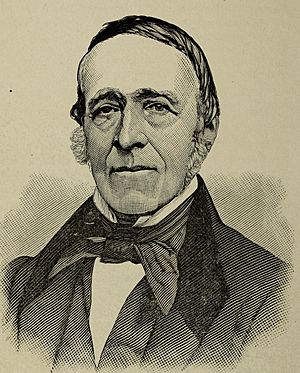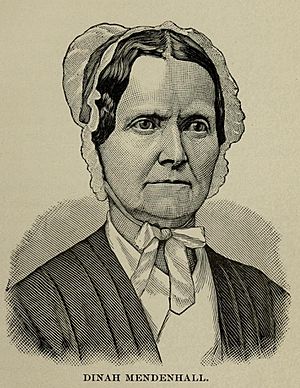Isaac Mendenhall facts for kids
Isaac Mendenhall (born September 26, 1806 – died December 23, 1882) was an American farmer. He was also an abolitionist, meaning he worked to end slavery. Isaac and his wife, Dinah Mendenhall, were important "station masters" on the Underground Railroad in Chester County, Pennsylvania. They helped hundreds of people escape slavery and find freedom. The Mendenhalls were successful farmers. They lived at their family home called Oakdale. This historic home is listed on the National Register of Historic Places. A special historical marker was put up in their honor in 2018.
Contents
Isaac Mendenhall's Early Life
Isaac's family had owned the Oakdale estate for a very long time. His ancestor, Benjamin Mendenhall, bought the land from William Penn way back in 1703. The property stayed in the Mendenhall family for generations. Isaac's oldest son, Aaron, later inherited the farm from his father. The main building at Oakdale is a large stone farmhouse. It is located in what is now Pennsbury Township.
Dinah Hannum Mendenhall (born October 15, 1807 – died November 22, 1889) was Isaac's wife. She was born in Kennett Township. Dinah was also a strong activist. She served as a vice president for the Universal Peace Union. This group worked for peace around the world.
Helping People on the Underground Railroad
Isaac and Dinah Mendenhall strongly believed in ending slavery. They also supported other important causes. These included the temperance movement (which worked against alcohol use), women's right to vote, and pacifism (the belief that war is wrong). They also believed people should be free to express their religious thoughts.
For over 35 years, the Mendenhalls were "station masters" and "conductors" on the Underground Railroad. This was a secret network of safe houses and routes. Many Quaker farmers in the Kennett Square area were part of this network.
Oakdale: A Safe Stop
Many freedom seekers came to Oakdale from Wilmington, Delaware. This city was only ten miles away. In Wilmington, Thomas Garrett and his wife, Rachel Mendenhall Garrett, ran a safe house. Rachel was Isaac's cousin. Thomas Garrett would tell people seeking freedom to "go on and on until they came to a stone-gate post, and then turn in."
To make sure people were truly sent by him, Garrett would give them a secret note. The note would say he had sent a certain number of "bales of black wool." This was a code to let the Mendenhalls know who was real. Oakdale was often the first safe stop north of Delaware for these brave individuals.
Hiding Places at Oakdale
The Mendenhalls had clever ways to hide people. Isaac designed a secret room in their carriage house. It was a hidden square chamber built between a fireplace and a wall. You could only enter it through a loft.
For larger groups, the Mendenhalls would hide men in their barn. Women and children would hide in their springhouse. After resting, "conductors" would guide or smuggle the enslaved people to the next safe stops. These stops were in towns like Darby, Pocopsin, East Bradford, Newlin, Lionville, or Philadelphia.
Helping people escape was very risky. If caught, the Mendenhalls could face arrest, jail time, and large fines under the Fugitive Slave Act of 1850. Even though no exact count was kept, it is believed they helped "several hundred" people reach freedom.
After the Christiana Riot
In 1851, an event called the Christiana Riot happened. After this, the Mendenhalls bravely sheltered four men who were wanted for serious charges. These men were William Parker, Alexander Pinckney, Abraham Johnson, and another person whose name was not recorded.
The men hid in the Mendenhalls' barn. They pretended to be regular farmhands, husking corn in the fields. If strangers who might be bounty hunters were seen nearby, the men would hide in the woods. After several days, a neighbor helped guide the men to another safe house. From there, they continued their journey all the way to freedom in Canada.
Isaac's Activism and Quaker Beliefs
Isaac Mendenhall was very open about his strong beliefs. He spoke out against slavery and supported women's rights and temperance. Because of these progressive views, he was "disowned" from his Quaker meeting, the Kennett Friends Meeting, in 1852. This meant he was no longer considered a member. Other reform-minded Quakers were also disowned at that time.
Isaac and other Quakers who shared his views started a new group. They became founding members of the Longwood Meeting of Progressive Friends in May 1853. Isaac served as the second treasurer for this new meeting. His son, Aaron, later took over this role. Interestingly, Dinah Mendenhall was never disowned by the Kennett Friends. There was a "division of sentiment" about her case.
Isaac was also the treasurer for the Chester County Anti-Slavery Society. He held this position from 1838 until the end of the American Civil War in 1865. Dinah was also a very active social activist. In 1862, she was part of a group that met with President Abraham Lincoln. They urged him to issue the Emancipation Proclamation, which would declare enslaved people free.
In 1851, the famous poet John Greenleaf Whittier wrote to the Mendenhalls. He praised them, saying they were always there to help the cause of freedom. He spoke highly of the "mental culture, moral stamina, and generous self-sacrifice" of the people in Chester County.
Isaac and Dinah celebrated their fiftieth wedding anniversary in May 1881. A large party with 225 guests marked this special occasion.
Isaac Mendenhall passed away at his home in Hamorton, Pennsylvania, on December 23, 1882. Dinah died a few years later, on November 22, 1889. They were both buried in Longwood Cemetery.
See also
- List of Pennsylvania state historical markers in Chester County
- National Register of Historic Places listings in southern Chester County, Pennsylvania
Images for kids





